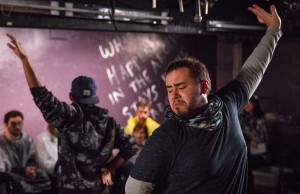Audience participation in Take Care consists of three levels—featured participants, group participants and voyeurs. Featured participants give solo performances, group participants perform with three or more people and voyeurs pretty much just watch. Participants are given instructions with a starting time, starting location, action, ending time and what to do when done. There are six to eight prompts that are to be performed within 50 minutes and the prompts usually involve making sounds, reciting lines and/or moving body parts. On the walls are television screens and digital clocks that count down the time and act as timers. During the performance, anyone—even the voyeurs—can go up to the microphone and pause the performance by saying “hold.” The clock stops and the person holding up the show can share their critique, comments, suggestions or requests about the production and the actors will respond. There is only one “hold” available for the whole performance.
All theatergoers receive personalized customer service from the moment they drop off their coats at the coat check to being escorted downstairs to their seats. Each point of contact provides theatergoers the opportunity to engage with the production before the performances even start. The actors offer the audience members mints and ask, “What is your desired level of participation?” No matter what level of participation a person chooses, the production provides a space for theatergoers to explore how they respond to emergencies and dangerous environments while in group situations.
The Flea Theater’s artistic director, Niegel Smith, partnered with his long-time collaborator, Todd Shalom, to create Take Care. Smith also directs The Flea Theater’s resident volunteer acting company, The Bats, in this production. At times, the actors feel more like supportive audience members or coaches guiding the participants through their scenes. Some of the most memorable, authentic and telling moments happen when the theatergoers share their personal stories at the microphone. For example, one woman shared about being discriminated against at the DoubleTree Hotel in Jersey City during Hurricane Sandy because she was black. Another woman, who had left Singapore because of religious persecution, was confronted with her past when a Singapore news channel wanted to interview her during Hurricane Sandy because she was Singaporean. A bartender talked about spending his time at work in Manhattan donating candles to people during Hurricane Sandy. Later, participants ask their neighbors if they can put their head in their lap or on their shoulder and then everyone watches a video of people kissing each other.
The value of the production is in the range of human emotions that are evoked and experienced by the theatergoers. Climate change, natural disasters, environmentalism, racism and many other subjects are covered throughout the show, but the topics go deeper than just being thought-provoking. Audience members feel alone and isolated within the group and then loving and comforting toward each other. The events have theatergoers distinguish their own resistance to helping fellow survivors. Take Care creates a dual experience where theatergoers feel like “we’re all in this together,” while at the same time, audience members go through their own personal journeys.
The material is relevant to the modern world and reads like it was more likely inspired by Hurricane Katrina than Hurricane Sandy. The production is effective enough as a fluent expression and does not get bogged down with the subject matter. Instead, the theatergoing experiences are personalized. If the overall aim and vision were to see if people really do take care of each other, then playwright and director Smith has achieved this. The play leaves theatergoers in a different place than where they started off.
The challenge with this production is its ability to travel outside of New York City and for theatergoers in other markets to relate. A greater balance between the positive and negative events that take place would make the uplifting scenes occur more natural and less out of place. More live singing and dancing could maximize the performances.
Take Care is recommended for theatergoers who do not mind getting a little wet and who are seeking something different. It is a participatory performance with a cast that really does care about its audience members. It is not recommended for those seeking a traditional theatergoing experience that involves passively observing. The production will likely trigger past events and transform how people relate to each other during a major disaster. It is also a production that theatergoers could experience every night of the week and never experience the same show twice since the participants are always different. Each participant alters the mood of the performance with his or her sharing. The next natural disaster that happens will likely share some of the same emotional elements that are exposed in Take Care.
Take Care runs until Jan. 25 at The Flea Theater (41 White St. between Church St. and Broadway) in Manhattan. Evening performances are Monday at 7 p.m. and Thursday-Saturday at 9 p.m. with no matinee performances. Tickets range from $15-$35. To purchase tickets, call 212-352-3101 or visit TheFlea.org.








